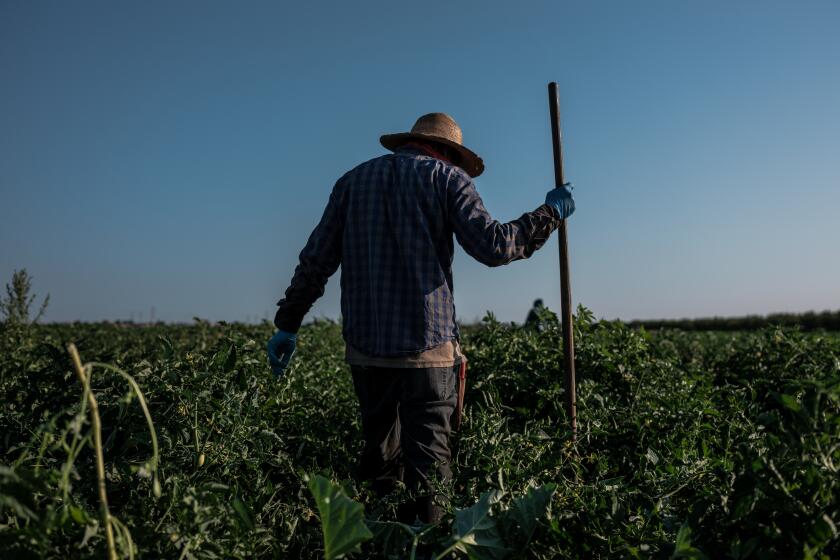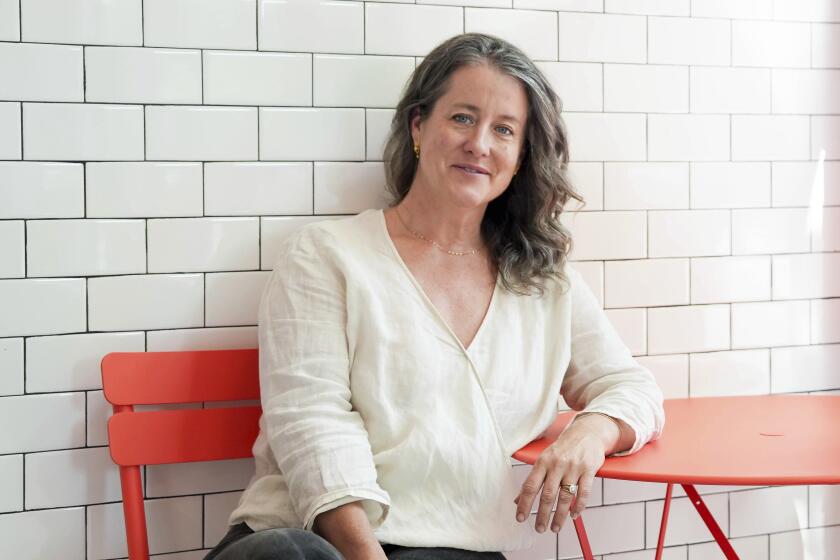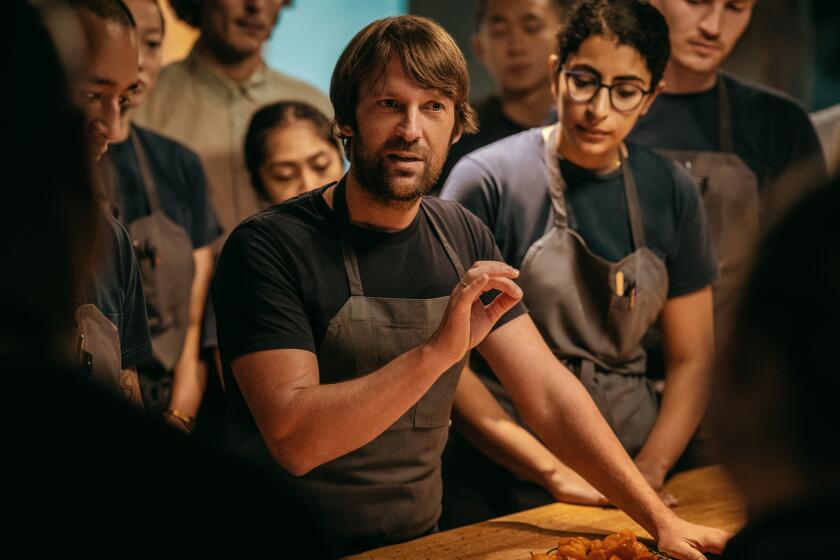ANNUAL HOLIDAY COOKBOOK ISSUE : A Few Good Cookbooks
MADISON COUNTY COOKBOOK
(St. Joseph’s Catholic Church, Winterset, Iowa: $21.95, 512 pp.)
This book has nothing to do with the novel, “The Bridges of Madison County” nor with the film. It has everything to do with wonderful small-town Iowa cooking.
The recipes, 500 of them, were gathered by the parishioners of St. Joseph’s Catholic Church, which just happens to be in Madison County, in the town of Winterset.
It’s a delightful collection, rich in warmth and tradition. You step for a moment into other people’s lives as you read, “Grandma always made this fudge for Christmas” or “My mother made sugar kuchen often, but it was a must at Christmas time” or “I triple this recipe for my family every holiday. I even have to hide these [butterhorn rolls] in order to have them for dinner!”
You look in on church socials past and present--fried chicken dinners, spaghetti dinners, picnics, brunches and smorgasbords, described in detail that makes you wish you had been there. And you regret not having known people like Marguerite Gallery, whose coffee cake recipe was contributed by a friend with the note: “Now and then after 8 a.m. mass she would have us stop by and she would put it in the oven. We would savor the aroma while baking and later enjoy the cake and coffee. Fond memories and good times.”
One section is devoted to tea traditions, another to Christmas memories, another to anecdotes from the parish and the county. But most of all there is really good food, lots of it.
The book isn’t available in most Southern California bookstores, but you can send away for it. Make checks for $21.95 payable to St. Joseph’s Catholic Church and send them to Cookbook, 607 W. Green Street, Winterset, Iowa 50273-1641.
*
One Dish Meals from Popular Cuisines
(Wei-Chuan Publishing: $14.95, 96 pp.)
You can take your choice of three languages and five cuisines when using this book. Tailored to small households (mostly two servings), the recipes explore foods of Italy, Thailand, Mexico, China and Japan. Each recipe is written in English, Spanish and Chinese, and each dish is shown in color photos that speak more clearly than any language.
Four cooks and a squad of translators produced this polyglot effort. The cooks are Victor Chang, chef-owner of Yamaha Japanese restaurant in Pasadena; Ken Kittivech of Chan Dara Thai restaurants; Jia-Tzu Yeh from Taiwan, and Diane Soliz-Martese, who handled both Italian and Mexican foods.
If you want Mexican pork chops tonight, udon in broth tomorrow, Hunan tofu the next day, then fettuccine followed by green curry beef, this is the book for you.
*
DANISH SISTERHOOD TREASURES
(Danish Sisterhood of America: $14.25, 322 pp.)
I plan to do my Christmas cooking from this book, partly because I am half Danish but mostly because the Christmas goodies--the cookies, cakes, rice puddings, sweet breads and pastries--sound so wonderful.
An old Danish custom is to serve rice pudding before the roast on Christmas Eve, when the main celebration takes place. The idea is to trim appetites so the meat will go farther. A single whole almond is hidden inside the pudding. Whoever gets it receives a gift--a marzipan pig.
The roast may be a goose stuffed with prunes and apples or pork stuffed with the same fruit. The book tells how to prepare these, along with such accompaniments as red cabbage and sugar-browned potatoes, the rice pudding and glogg, the holiday beverage. After dinner, the Christmas tree is lighted, and the celebrants dance around it, then open gifts.
Master bakers, the Danes come into their own at Christmas with scrumptious cakes, cookies, and pastries rich with butter, eggs and almond paste. “Danish” has become a buzzword for sweet rolls, most of which are little like real Danish pastry, as you can learn from making the recipes in this book. Along with Danish apple cake, kringle, marzipan cakes, peppernuts, spritz, klejner and much more, there’s a recipe from Copenhagen for cardamom-flavored fruitcake that might stir up new interest in this often maligned holiday specialty.
The Danish Sisterhood of America is a fraternal organization founded in Michigan in 1883. California has 10 lodges, including one in Solvang, the Danish community adjacent to Buellton. Else Lassiter of Solvang Lodge 177 is national president and also editor of the organization’s monthly newsletter. She started the cookbook by requesting Danish recipes for that publication.
Recipes from Solvang include several from Lassiter and other sisterhood members, curried cauliflower from the Mollekroen restaurant and Danish layered rum cake (Othello) from Olsen’s Danish Village Bakery. Anyone who has enjoyed eating aebleskiver (Danish pancake balls) in Solvang will find four recipes for them, each slightly different.
The book ends with chapters on Christmas traditions, smorrebrod (open-faced sandwiches) and the Danish cold table, a buffet of prepared dishes typically served the day after Christmas and on other convivial occasions.
To order a copy, send a check for $14.25, which includes shipping, to Danish Cookbook, 3176 Horizon, Santa Ynez, Calif. 93460.
*
THE SPICE TRAIL
By Sandeep Chatterjee
(Ten Speed Press: $15.95, 141 pp.)
Sandeep Chatterjee runs an Indian restaurant in Sydney, Australia, and once cooked at the Bombay Brasserie, a restaurant in London that some of my Indian friends like very much. Other than his cooking resume, you learn nothing about Chatterjee from this book. And you need to know much more to explain why he includes a handful of recipes from Vietnam, Cambodia and other Southeast Asian countries in this collection of 100 spicy dishes. Did he once live or work in those countries? That would give some validation to recipes that look like little more than filler to support the book’s title. It’s not enough to state that traders from India sailed throughout the region. To explore those ancient links would take a bigger, investigative book.
Fortunately, most of Chatterjee’s recipes are from India and countries more closely involved with India and its cuisine, like Pakistan, Bangladesh, Sri Lanka, Iran and Myanmar. These are reason enough to buy this book, and I wish Chatterjee had devoted all the space to them. Perhaps one day he’ll do an Indian cookbook that will incorporate more of his own viewpoint and experience.
*
FROM THE EARTH TO THE TABLE
By John Ash with Sid Goldstein
(Dutton: $29.95, 448 pp.)
John Ash has access to the sort of ingredients most of us only dream of. He’s culinary director of the Fetzer Vineyards’ Food & Wine Center at Valley Oaks near Hopland in Mendocino County. That means he can cook with an incredible variety of produce from Fetzer’s five-acre experimental organic garden.
Although Ash can work with tomatoes, beans and greens not yet available commercially, most of us are able to obtain wonderful fresh produce through growers markets. Ash’s recipes help us to celebrate this abundance.
Founder of John Ash & Co., a Santa Rosa restaurant where he still consults, Ash is an imaginative but practical chef. He tells how to dry tomatoes without a special drying apparatus, how to make tomato paste, how to produce dried citrus peel using the microwave oven, how to make infused oils and how to concoct such seasoning blends as Chinese five spice powder.
These tips, including two ways to peel garlic that I had not heard of, are scattered through a long collection of interesting recipes. (If you should buy this book, be sure to make Ash’s butternut squash soup during the holidays. It is exceptional.)
Ash advances the concept of grilling or roasting vegetables rather than boiling or steaming them. And he has a wine selection for each dish, including salads, which are more wine-friendly today than in the past because they incorporate meatier ingredients and employ greens with fuller flavor.
The idea of a concluding chapter on matching wine with food is predictable, but Ash goes beyond the expected to chart herbs and the wines they connect with and then gives his tasting notes on edible flowers, many of which bloom in the Fetzer garden.
More to Read
Eat your way across L.A.
Get our weekly Tasting Notes newsletter for reviews, news and more.
You may occasionally receive promotional content from the Los Angeles Times.






